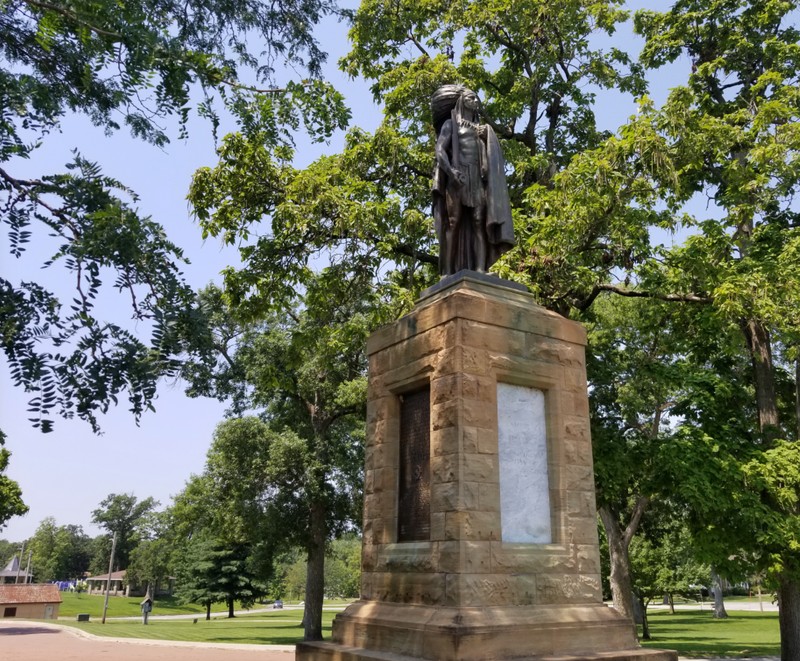Keokuk Memorial
Introduction
Text-to-speech Audio
Located in the east end of Rand Park, this memorial commemorates Sauk Chief Keokuk (c.1780-1848), who was one of the most famous Indian leaders during the first half of the 19th century. He was known for his friendly relations with Americans and cooperation and diplomacy with the federal government. The city of Keokuk is named after him. The memorial, which was erected in 1913, consists of a stone base with the original marble marker of Keokuk's first grave and statue of Keokuk overlooking the Mississippi River. Some of Keokuk's remains are buried underneath the base.
Images
The Chiek Keokuk Memorial is located in Rand Park. The city is named after him.

Backstory and Context
Text-to-speech Audio
Chief Keokuk was born c. 1780 along the Rock River in present-day Illinois. His father was a Sauk warrior and his mother was of mixed lineage. When he was a young man, he became a full warrior after he killed a Sioux brave. He was also a skilled orator which enabled him to become the guest keeper of his village and a member of the tribal council. During the War of 1812, his stature in the tribe rose further. Upon learning that Americans would attack the main Sauk village (Saukenuk; near modern-day Peoria, Illinois), he announced would lead the defense of the village and was named war chief. The majority of Sauk warriors had already left with another chief, Black Hawk, to fight for the British. The Americans did not attack the village but Keokuk retained the title.
Keokuk's status and influence continued to grow in the coming years. He became a diplomat and in 1824 went with a delegation of Indian chiefs of various tribes to Washington D.C. to negotiate changes to treaties with the federal government. Seeing first-hand how strong the federal government was in terms of population and resources, the visit appears to have reinforced Keokuk's belief that maintaining good relations with whites was essential for his people's survival. Black Hawk held the opposite view.
In a July 1830 treaty with the federal government, the Sauk and Fox tribes ceded 26 million acres land east of the Mississippi River. The treaty also established neutral ground between the Sauk and Fox, as well as the border with the Sioux, who were the traditional enemies of both tribes. In the Spring of 1830, Black Hawk and his followers left to hunt. When they returned they found white settlers in Saukenuk. Angry at what had transpired while he was gone, Black Hawk decided to fight the Americans and rallied some of his followers to the cause. Keokuk was unable to convince him otherwise. The result was the Black Hawk War of 1832, which the Americans won. After the war, the Sauk and Fox were forced to cede more territory and Keokuk was designated principal chief by the federal government.
Keokuk and a tribal delegation went to Washington D.C. again in 1837 to resolve land disputes with the Sioux. Despite having representing his tribe well in Washington D.C., Keokuk's stature as principal chief and also as one of three official distributors of tribal annual annuities caused resentment and division among the Sauk and Fox.
During the next few years, the living conditions among the Sauk and Fox deteriorated as the available game to hunt decreased and debt to traders rose. Keokuk agreed to sell the rest of the tribal land Iowa and move his people to a reservation Kansas, which they did in 1845. Keokuk died three years later and was buried in Kansas. In 1883, a collector of Indian relics found the grave and and reburied Keokuk's remains in Keokuk (as noted above, the collector also took the grave marker). However, the skull and one arm were missing. The collector went back to Kansas and acquired a skull and kept it in his collection, which was eventually donated to the State Historical Museum. In 1987, it was discovered that the skull belonged to a young man and was therefore not Keokuk's.
Sources
"Chief Keokuk." The Wild West. Accessed December 21. 2021. https://thewildwest.org/chief-keokuk.
"History of Keokuk." City of Keokuk. Accessed December 22, 2021. https://www.cityofkeokuk.org/community/history-of-keokuk/.
Iowa Culture. "The Grave of Chief Keokuk." Medium. October 30, 2015. https://medium.com/iowa-history/the-grave-of-chief-keokuk-79347440f0c1.
"Keokuk." The Biographical Dictionary of Iowa. Accessed November 21, 2021. http://uipress.lib.uiowa.edu/bdi/DetailsPage.aspx?id=205.
"Keokuk Memorial." The Historical Marker Database. Accessed December 22, 2021. https://www.hmdb.org/m.asp?m=186354.
The Historical Marker Database
